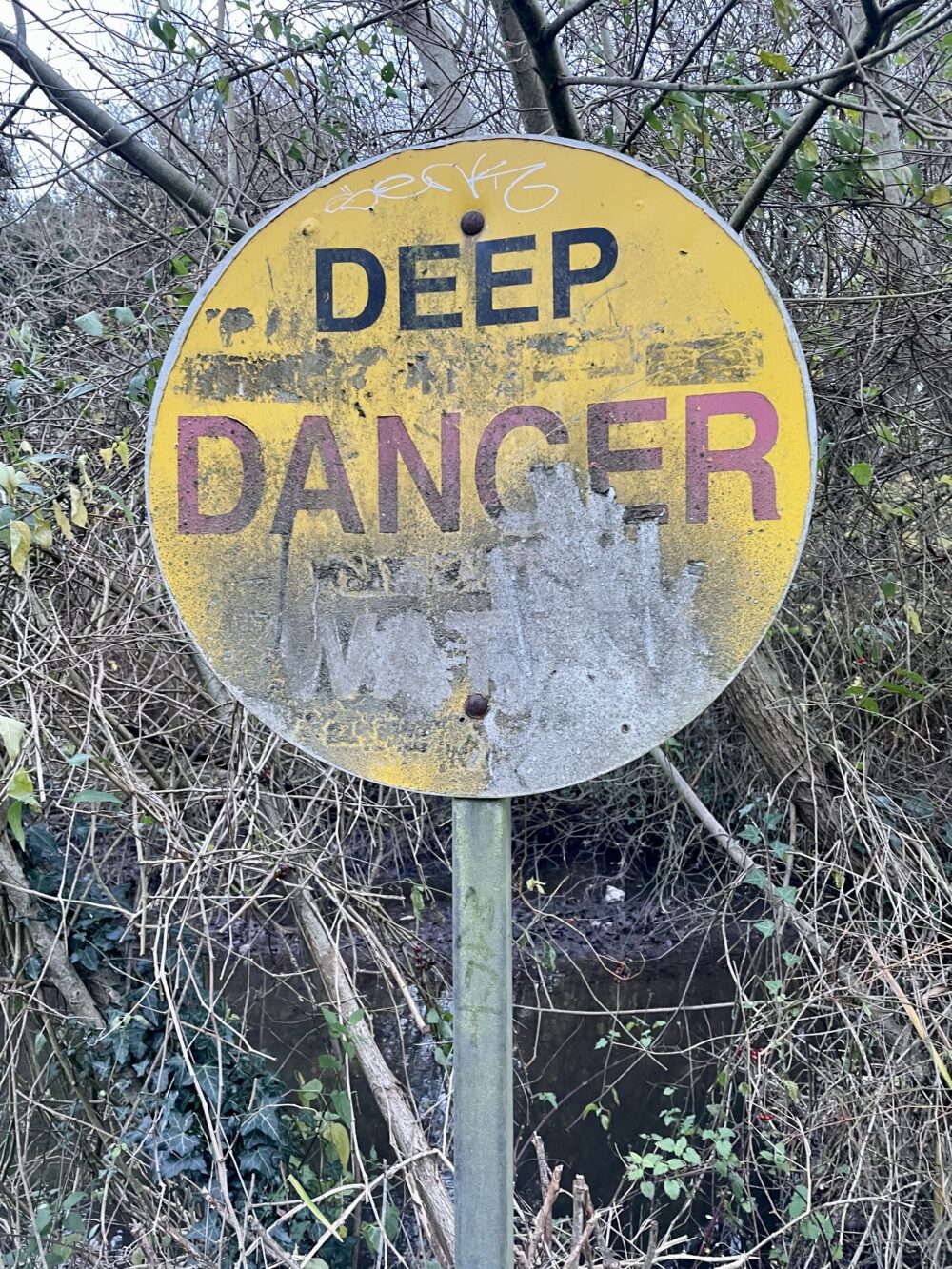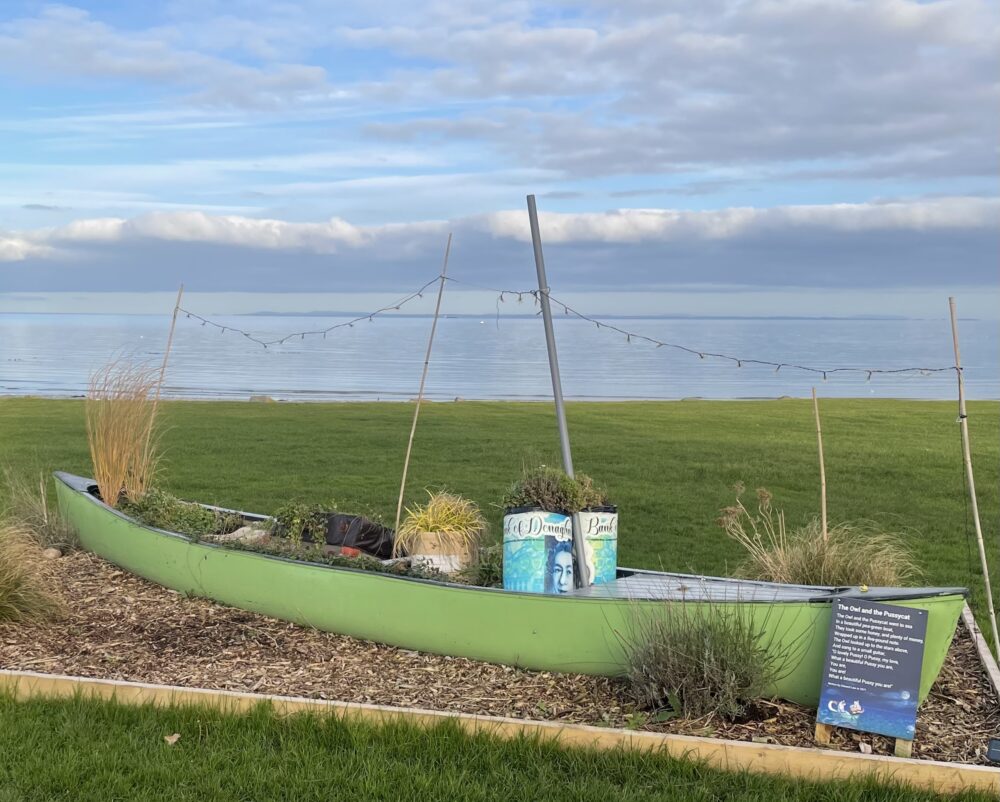
A €38m lesson with my latte
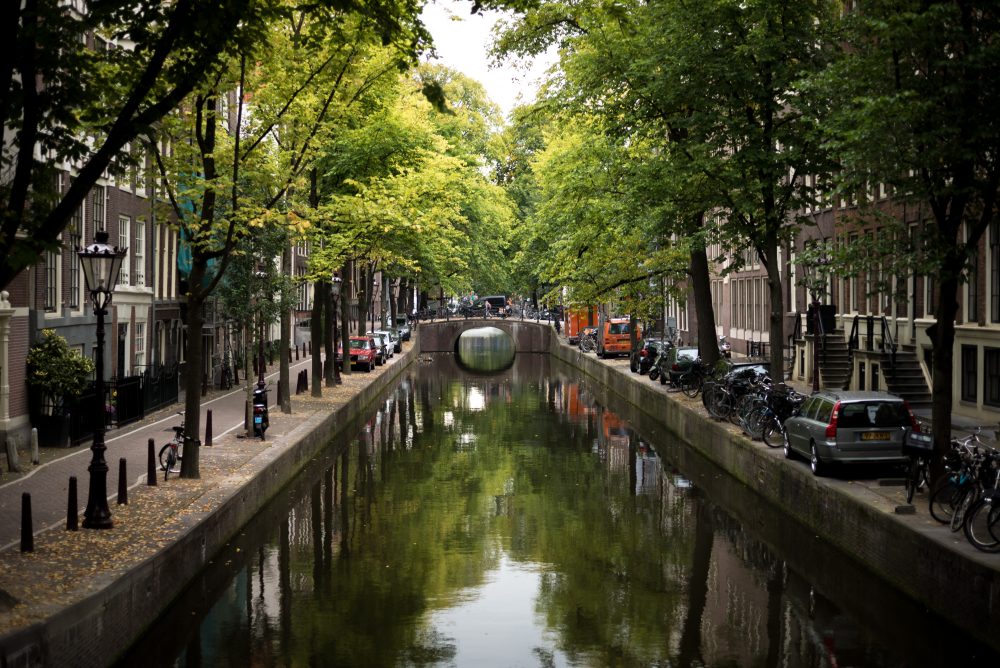
Yesterday, I stopped for a coffee in the lobby of one of Amsterdam’s more upmarket hotels. I settled into a stylish yet surprisingly comfortable armchair next to a wrought iron room divider, and cracked open Fay Weldon’s The Life and Loves of a She Devil. Before I knew it, though, I had stopped reading, and instead tuned in to the intriguing conversation on the other side of the divider.
At a coffee table was a man with a shaved head, who looked of a similar age to me, wearing a white shirt, and a somewhat over-tight unfastened blue suit jacket, pale blue denim jeans, and black suede shoes. Opposite him, with their backs to me, were a man and a woman, each in smartly conservative suits, with leather folios of notes and papers before them. All three were served cappuccinos.
My ears pricked up when the conversation revealed that the man in jeans was confirming and signing the paperwork for a €38m personal loan: that’s not a conversation one hears every day, and not one that I would have expected to hear in such a public place. It turned out that the loan was to fund the purchase of a luxury boat from the man’s father, at below market value as it was partly being offered as a gift. The man intended to use the boat for general recreation, but also had designs on renting it out commercially for cruises, as acquaintances with similar boats were reputedly wont to do.
I know very little about luxury boats. I’ve seen articles in newspapers and magazines about million-pound super-yachts, but I can’t even conceive of what sort of vessel €38m buys you – let alone the full amount including the ‘gift’. I’d believe you if you told me this was a conversation about a four-bedroom yacht that one might sail into a small harbour, and I’d also believe you if you told me this was a conversation about a mini cruise ship with tens of rooms that would require dedicated port facilities. I’ve really no idea. And I’ve also no idea on what sort of terms a €38m personal loan would typically be offered: it’s never a conversation that’s crossed my mind, let alone one that I’m ever likely to take part in (especially if I spend all my money on expensive coffees in posh hotels). And so I was intrigued. Fay Weldon was not going to receive much attention as I sipped this particular latte.
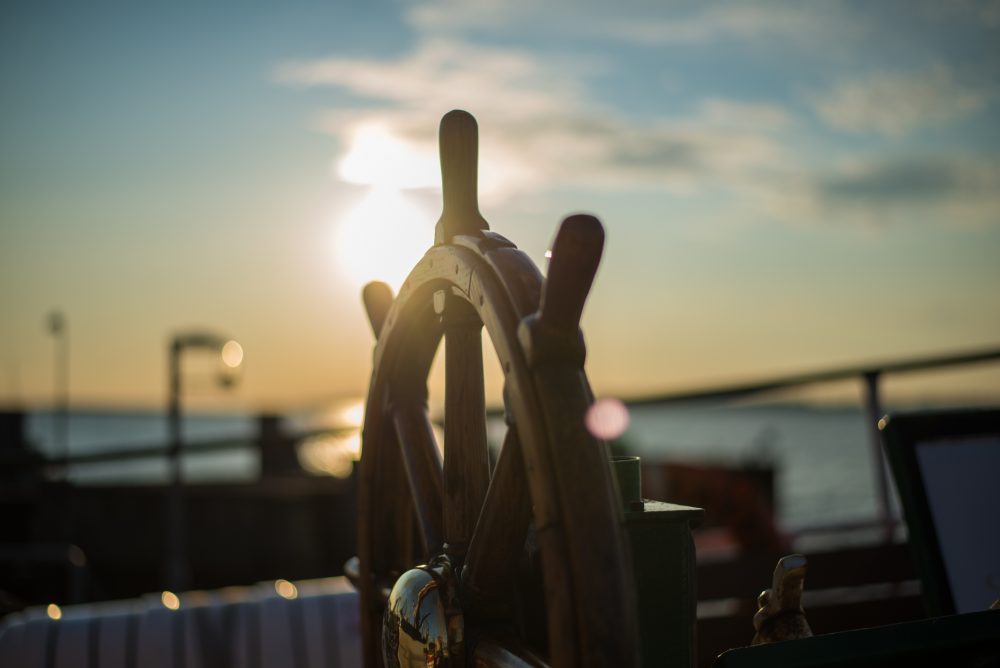
As the conversation progressed, the man in jeans explained that he was confident in the arrangement because he was near certain that his pay cheques would cover the loan repayments whether or not he got round to renting the boat out (goodness only knows what his job was), and if he should fall on hard times, he could sell the boat and easily pay off the loan given that it was for less than the market value. So to this nosey parker, listening through the divider, the deal seemed as sensible as a loan to spend €38m on a boat ever could.
Yet just as he was on the verge of signing the paperwork, the man asked a question which confounded me: “Given that there are no arrangement fees, why are you charging me such as low interest rate?”
The man went onto explain that he was concerned that he had misread the wisdom of the deal. The loan provider had sent two members of staff to meet him in Amsterdam from their offices elsewhere in Europe, at presumably high cost to their firm. The amount of money being borrowed was substantial. The low interest rate meant that the profit they would make on the deal would be small in comparison with the outlay. Why, the man wanted to know, weren’t they pushing for more? Were they expecting that he would default on the loan, and that they would recoup a greater financial prize from the fallout? Were his assumptions about the safety of the deal wrong? What did they know that he didn’t?
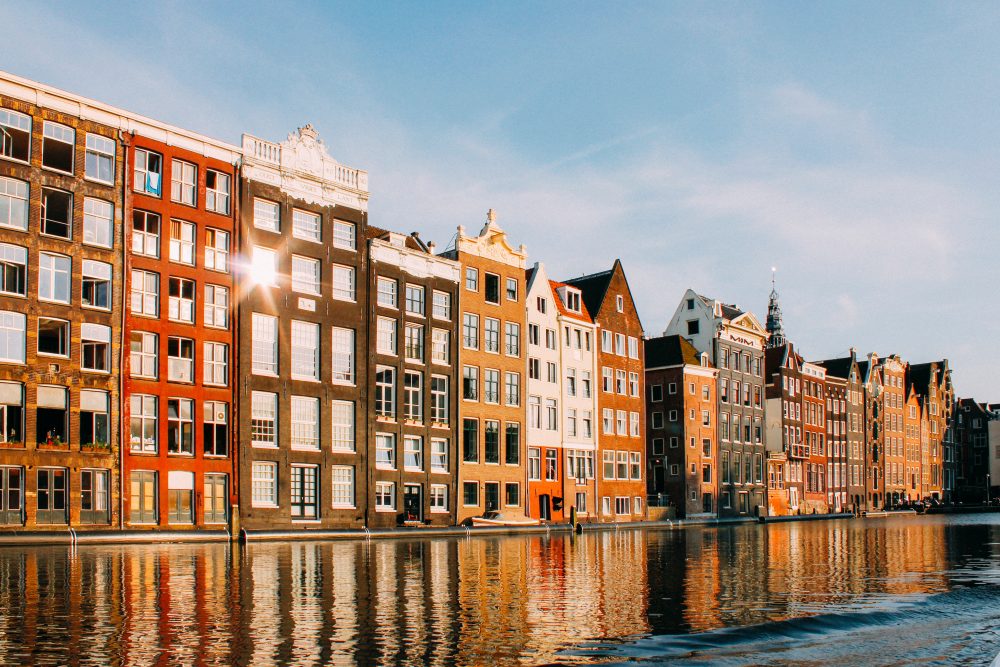
This question confounded me because it’s not common to hear someone clarify the reasons for suspected undercharging. I’m not sure I would have done so—not that I’m ever likely to borrow €38m—because I think I would have been concerned that the lenders would raise their price to meet my expectations.
Yet on my way to Amsterdam, I’d just finished reading Thanks for the Feedback by Douglas Stone and Sheila Heen. This book makes the case that receiving feedback is an interactive process, and we should always seek to understand the point of view of the person giving the feedback. The interest rate on this loan is clearly a type of feedback from the lender.
By discussing the rate with the lenders, the man in jeans could either avoid a huge and costly financial miscalculation on his part, or could set his mind at rest. If the lenders had jacked up the rate in response to his question, he could always have taken his business elsewhere—and, of course, the lenders were unlikely to do so for exactly that reason.
The decision by the man in jeans to have this conversation could have only positive effects: and yet, it is a conversation that I would naturally have shied away from. I suppose, given that he was taking out a €38m loan, the man was probably more used to large scale financial transactions than me. It wouldn’t be an absurd supposition that his day job may be in the financial sector. Perhaps that is why he had he confidence that I would have lacked to initiate this conversation.
But that’s a very easy get-out for myself. What other conversations do I shy away from for illegitimate reasons? Do I avoid asking things that could help prevent me from making unwise decisions because I lack the confidence to ask them? There’s some food for thought and reflection.
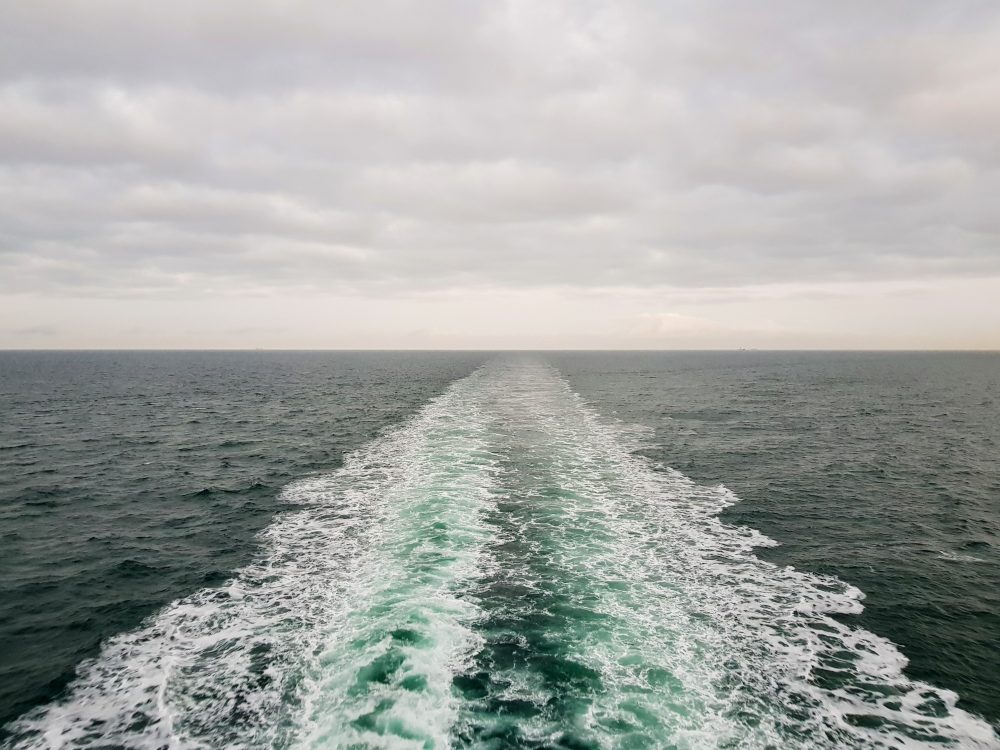
And the answer to the man’s question? Simple, really, according to the lenders. Pricing for loans is risk-based. The loan is secured on the boat which is worth more than the total value of the loan regardless. The terms of the loan state that appropriate insurance must be in place. Even if the man fails to make his repayments, the risk of the lenders not receiving their capital back is very low: such low risk investments for such large amount of money are rare. And besides, even at a low interest rate, the lenders stand to make hundreds of thousands of Euros in pure profit, because a small percentage of a very big number is still a big number.
Before long, the paperwork was duly signed and all three were on their way. The meeting lasted twenty, maybe thirty minutes. If I were one of the lenders, travelling internationally for such a short meting would feel like a waste of time, even though I’d just brought in a huge amount of profit for my firm. But as someone travelling solely for pleasure, I think this was possibly one of the most thought-provoking and educational coffees I’ve sipped in a very long time.
Most of the pictures in this post are not my own, though I did post a nice picture I took at the Rijksmuseum in ‘real time’. In this post, the first picture (Amsterdam) is by Boudewijn “Bo” Boer; the second (a ship’s wheel) is by Maximilian Weisbecker; the third (Amsterdam again) is by Javier M; and the fourth is my own picture of a boat’s wake, co-incidentally taken from the back of the DFDS ferry to Amsterdam (though not on this trip). All are used with grateful thanks, and under the terms of their Creative Commons licences.
This post was filed under: Miscellaneous, Posts delayed by 12 months, Travel, Amsterdam, Finance, Reflection, Travel.
La Sagrada Família
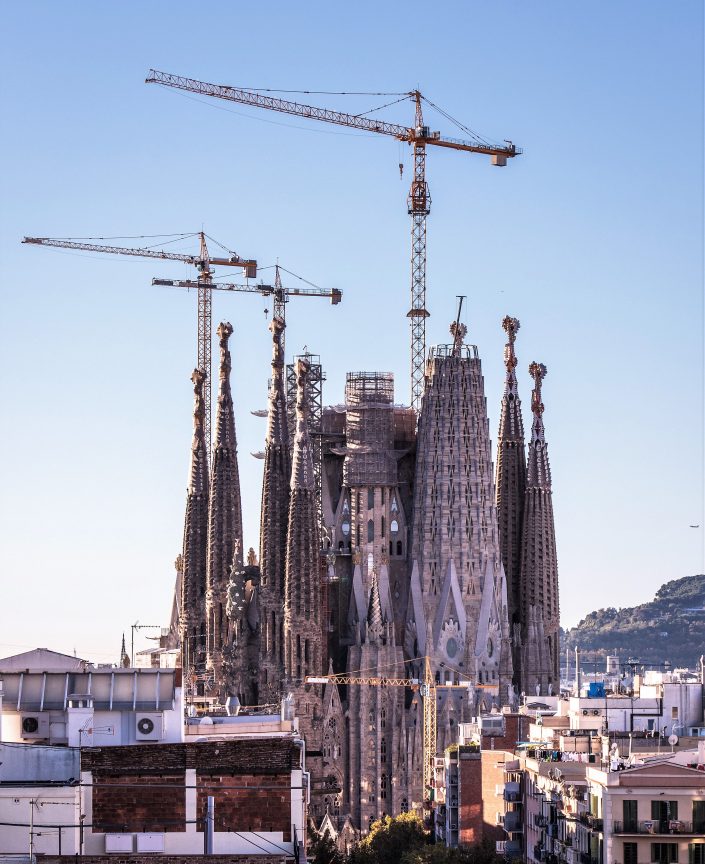
Earlier this week, I was in Barcelona for one of my occasional solo weekends in Europe. Normally, I like to spend these brief breaks doing absolutely nothing: I like simply to wander around with no particular destination in mind, taking in the sights and sounds of somewhere new and occasionally stopping on a bench or in a coffee shop to read for a little while. I enjoy spending time with my own thoughts.
This time, however, I made an exception to my rule. When I told people I was going to Barcelona, several people exhorted me not to miss the Sagrada Família.
Construction began on the Catholic ‘Church of the Holy Family’ in 1882, and from 1883 Antonio Gaudí became its chief architect. Much of his life was dedicated to design and construction of the church, and indeed he lived on site for quite a number of years. Following his death in 1926, construction has continued—often slowly, and often with considerable controversy—and it is currently estimated that the building will be finished in 2026, give or take a few years for the final bits of decoration to be finished.
Prior to visiting, I wasn’t particularly familiar with Gaudí’s work. I’ve never previously visited Barcelona, where his influence is pretty much unavoidable, and I can’t claim to be well-read in architecture, so it’s probably no surprise that I don’t think I’d ever really come across Gaudí before. Nevertheless, I couldn’t ignore the exhortations of friends, and so bought myself a ticket to visit.
In fact, due to the illogical position that “entry only” tickets had sold out, I ended up buying an extra-expensive ticket which included an “audio guide”, as if to add an extra layer of interruption to my planned day of wandering and contemplation.
The reason I’ve felt compelled to write about this visit is that I’ve never before felt so profoundly conflicted about a building. Several friends who encouraged me to visit have since asked what I thought of it, and I’ve struggled to string together a semi-coherent response, because I have such strongly logically inconsistent opinions. And so I thought I would try and set down here the answer to the question of what I thought of the Sagrada Familía. But, as with some of my other recent posts, I’m only publishing it twelve months later, so you may have been waiting quite a while for an answer.
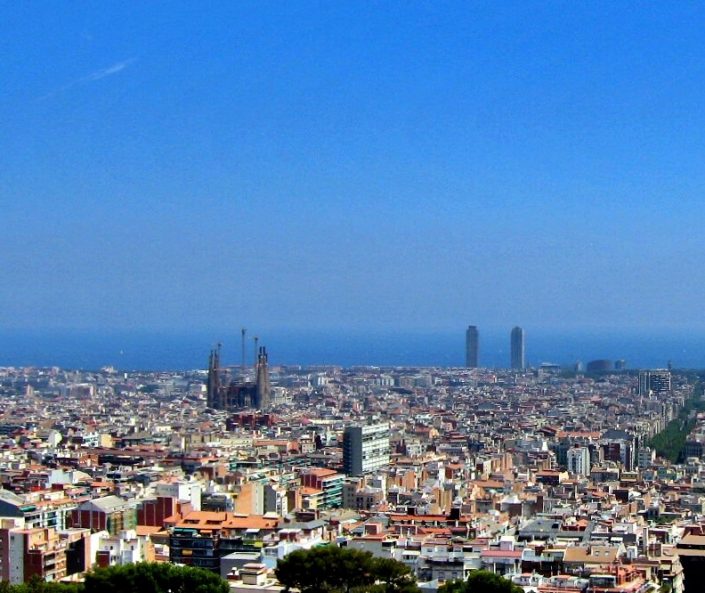
La Sagrada Família is a building of awesome scale: it dominates the landscape in a way which seems almost out of place in a city. The basilica covers an entire city block and, even in its incomplete form, has an imposing height to figure alongside its great mass. I was staying in a hotel three miles away, and could still clearly see the building from my hotel’s window, across the city’s rooftops. From this distance, there is something oddly other-worldy and inhuman about it. Seeing its mass within Barcelona’s grid system, conforming to a city block’s size yet still being utterly disproportionate in scale, reminded me of nothing quite so much as one of those occasionally odd buildings that would spring up in Sim City 2000.
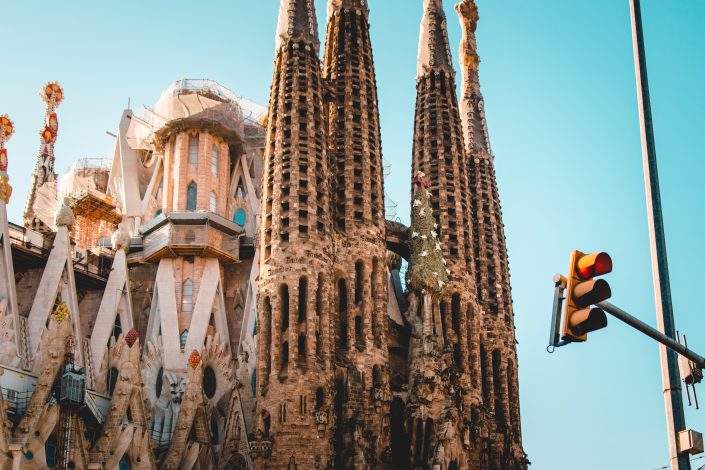
I approached from the east, walking along Avinguda Diagonal, meaning that the basilica came in and out of view according to the gaps between the buildings. The closer I got, the more spectacularly ugly the spires appeared, covered in horizontal openings. These opening serve to let the wind blow the tubular bells yet to be installed within, and also to lend a ‘natural’ appearance to the architecture: something repeated throughout Gaudí’s work.
I have no doubt that to create huge spires which are open structures from stone requires true architectural genius. How could it not? They are clearly both intricately constructed with an eye toward delicacy, and yet strong enough to withstand enormous forces acting upon them. Delicacy and strength rarely go together.
And yet, to my eye, they look like nothing quite so much as insect nests that I’d call Rentokill about. They strike me as thoroughly aesthetically unpleasant. This impression was only reinforced when I got close enough to see that they have occasional fragments of text carved into them at huge sizes visible from the ground. They really are arrestingly ugly.
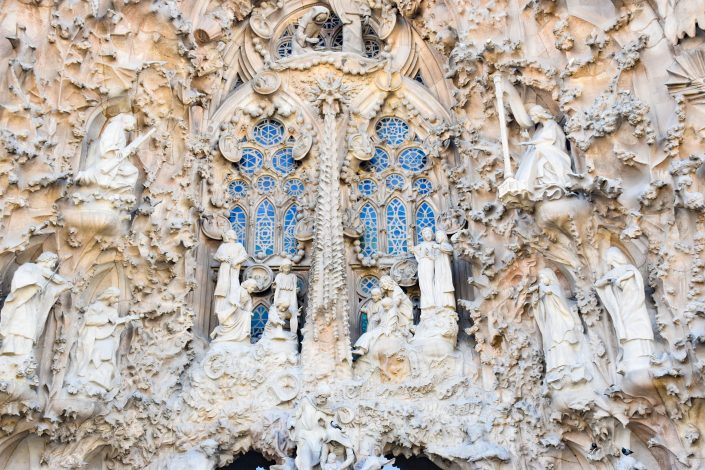
The Basilica will eventually have three facades, capturing different points in the Holy Family’s life as described in the Bible. The first I came to, and indeed the only one constructed in Gaudí’s lifetime, was the Nativity facade. This astounding structure makes stone look as malleable as clay. The entire facade is covered in leaves, plants and statues which are so detailed and intricate as to be quite astonishing. Gaudi’s original plans for this facade was for the stonework to be painted to make it even more lifelike, which hasn’t happened and (for reasons I didn’t quite pick up) no longer seems to be part of the plan. Many of the features are no longer original, having been damaged in protests over the years, but none stands out as inauthentic.
Yet, for all the obvious skill and talent which has gone into the construction of the facade, it looks like the dictionary definition of religious kitsch. The interpretation of the Nativity is, even to an unbeliever like me, almost offensively literal. The facade looks as though the intention was to jam-pack it with decoration, and anything and everything that could be literally represented in stone has been stuck on, with no particular thought to any religious or spiritual significance. Hence, “Joseph was a carpenter” becomes a sculpture of a carpenter with a young boy looking on.
The skill and detail is astounding – but the overall effect is that of a desperately tacky and overwrought Christmas decoration that might be erected each December outside one of the US Bible Belt’s megachurches. Or perhaps, if a little more gold were added, like something Donald Trump would construct at one of his homes. It struck me as being in the most awful taste.
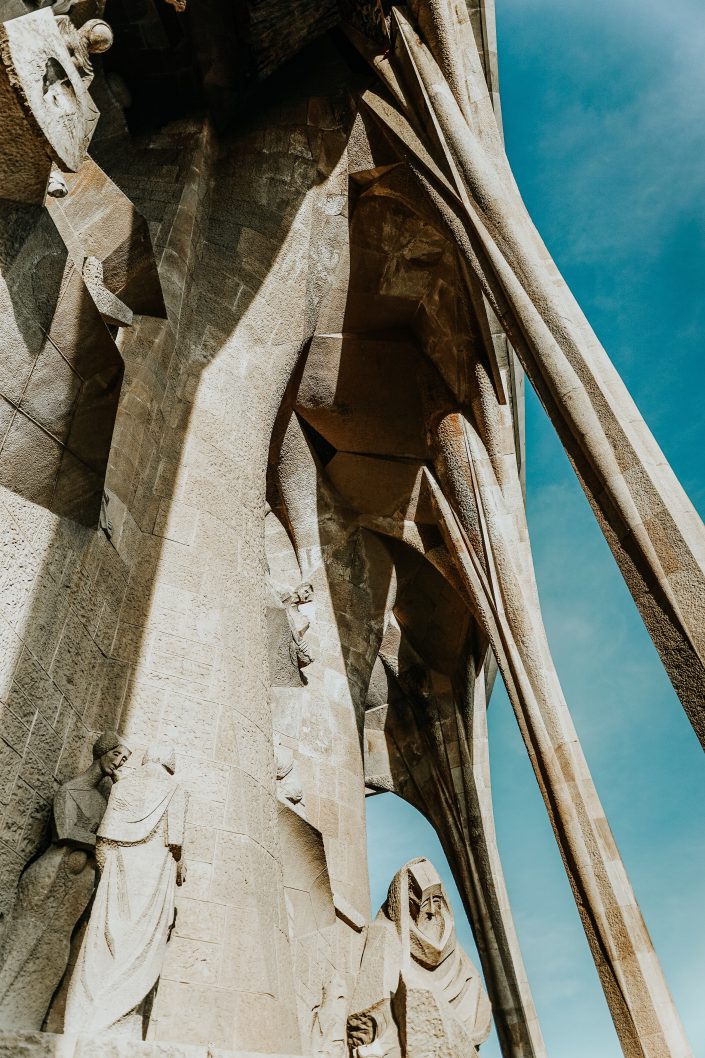
On the opposite side of the Sagrada Família, directly across the transept from the Nativity Facade, one finds the Passion Facade. This provides an extreme contrast to the exuberance of the Nativity Facade: it is relatively sparsely decorated, angular and severe. There is a clear intention to provoke a contrasting emotion among viewers of this facade as compared to the Nativity Facade: indeed, Gaudí’s intention was to provoke fear among viewers.
On the Passion Facade, the architecture is more exposed as as result of the reduced decoration, and it struck me as all the more impressive for this. The visual trick of making thin ‘ribs’ of concrete appear to support the (still ugly) massive spires above is neat, inspired, and clearly related to the ecclesiastical meaning of the events the facade represents, which gave me a much greater sense of overall coherence than the literal presentation of the Nativity Facade.
And yet, the literal interpretation is still very much in evidence, particularly in the angular sculptures by Josep Maria Subirachs. These sculptures are so angular that the figures portrayed all appear to have cubic heads. This provides an echo of the surrounding angular architecture, but has the unfortunate side-effect of rendering the figures pretty emotionless. This was particularly striking for me in the figures of Jesus—who looks mildly fed up—and the figure of St Peter—who looks a bit sad.
The most interesting consideration in the Passion story, at least for me (but I would also have thought it pretty fundamental in Catholicism) is the emotional toll on the primary characters. The scale and complexity of their emotional states is mind-boggling, and this complexity well-represented in enigmatic portraits through the centuries. Rendering them as figures out of Minecraft provides a neat continuity with the architectural style, but man it sucks all of that emotion out of the scenes, and leaves them once again being little more than a story-telling diorama.
There’s also the confounding inclusion of a magic square stuck on this facade. I can’t fathom why this grid, not obviously associated with Catholicism or Christianity, is incongruously included in a prominent position on this facade. The solution to the magic square is the age at which Jesus died, but why represent this using a technique associated with both paganism and mathematics, rather than something more obviously religious? It is particularly out of place given the generally sparse decoration.
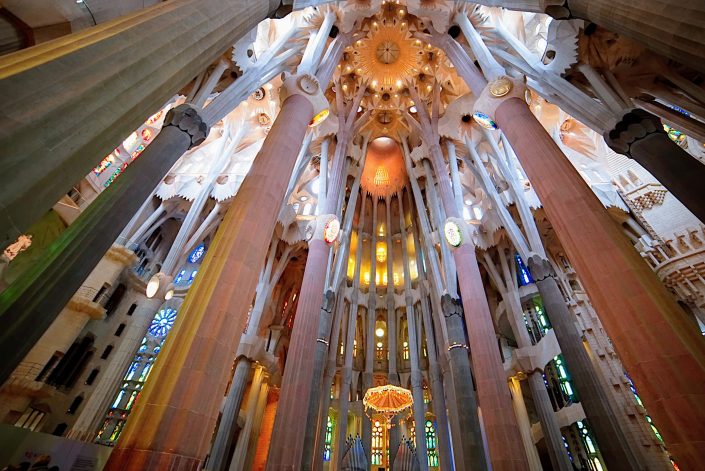
Entering the basilica, I found the interior to be utterly breathtaking. The scale of the space is hard to comprehend, and it seems almost implausible that the narrow branching columns within can support the load of the ornate roof which seems to be hovering at something like sky-height. And then one remembers the massive spires towering even above that, supported by those self-same columns. It is genius.
The basilica is flooded with light from the stained glass windows, brightened by the more delicate leadwork than is commonly seen in older church buildings. The dominant colours of the windows on each side of the Basilica are carefully chosen to bathe the inside in particular hues of light, giving it a strangely ethereal feeling. It is an awesome space, arresting and moving all at once.
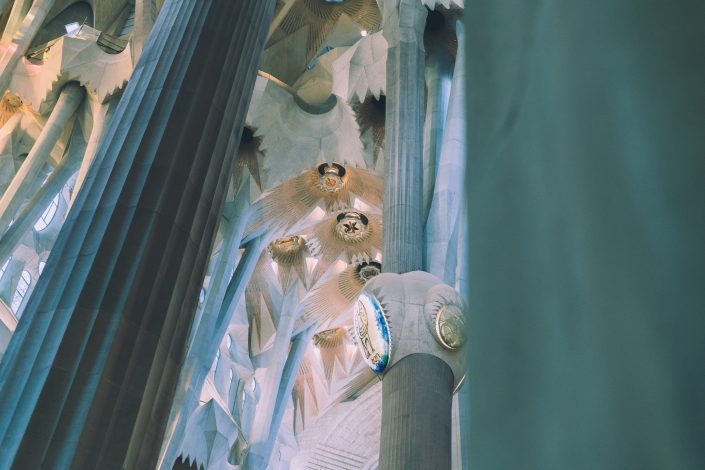
Unfortunately, the decor of the interior continues the profoundly kitsch theme, mostly notably with four huge back-lit medallions representing four saints situated high up on the four largest columns. These wouldn’t look out of place on a fruit machine.
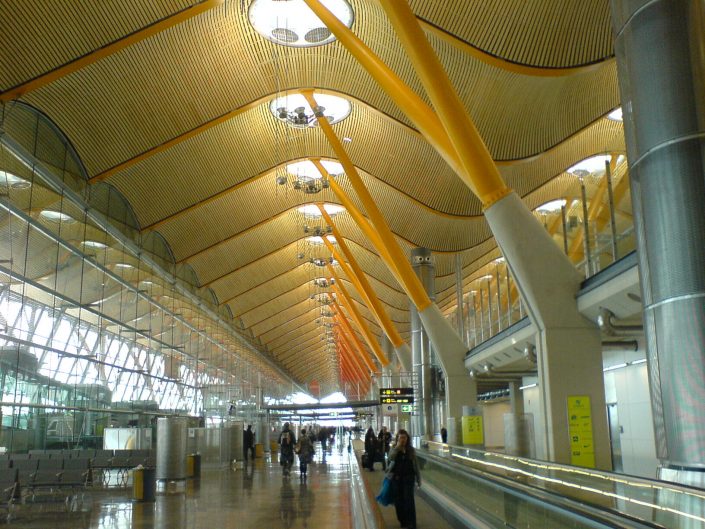
The comparison may be unflattering, but the construction of the interior reminded me of Richard Rogers’s Terminal 4 at Madrid Barajas airport. Of course, it is all the more impressive to see this sort of structure built from stone, and on a much greater vertical scale, than it is to see the steel equivalent. But it is interesting to contemplate the way in which Terminal 4 was lauded for it’s shockingly open and modern design, and yet note how similar it is to something designed almost two centuries ago.
Underneath the basilica, there is a museum which explains much of the architectural significance of the building, which is well worth a visit (particularly if, like me, you know nothing about architecture). I was particularly taken by a series of scale models which demonstrate how the structure was derived from the classical Gothic architecture originally proposed for the Sagrada Família, before Gaudí got involved.
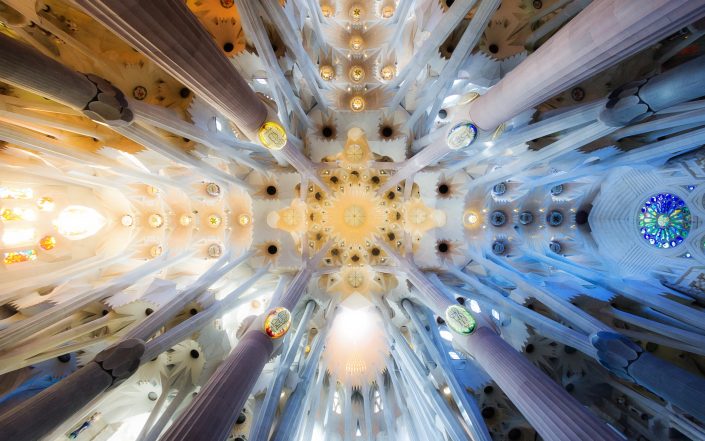
As I wandered round the basilica, I kept trying to reconcile my mixed feelings. How could I be awed and appalled at the same time? Exactly what was it about the decor of the building that made me feel so uneasy? Why couldn’t I just appreciate the undeniable beauty that was before me? I kept thinking back to something I read in Alain de Botton’s uncharacteristically disappointing book, Religion for Atheists:
The most boring and unproductive question one can ask of any religion is whether or not it is true.
The kitsch literal descriptions of Biblical events that flow throughout the Sagrada Família seem to invite no more contemplation than wondering whether or not the tales were true. They did not inspire, in me at least, any deeper reflection on their meaning, and nor was the imagery arresting and memorable. I found myself thinking that if Disney made cathedrals, they’d be much like this basilica.
Safe to say, then, that the exterior decoration was not at all to my taste. Not at all.
And yet, for all that, there was a style and theme that carried throughout the building. There was a vision of how it should look, and despite over a century’s worth of opportunity to dilute that vision, it is clearly being maintained. There is something deeply admirable and impressive about this scale of implementation of a vision, even if that vision seems as tacky as hell. It may not be inspirational to me, but it must clearly be inspirational to many people to have persisted for so long. It is hard not to be awed.
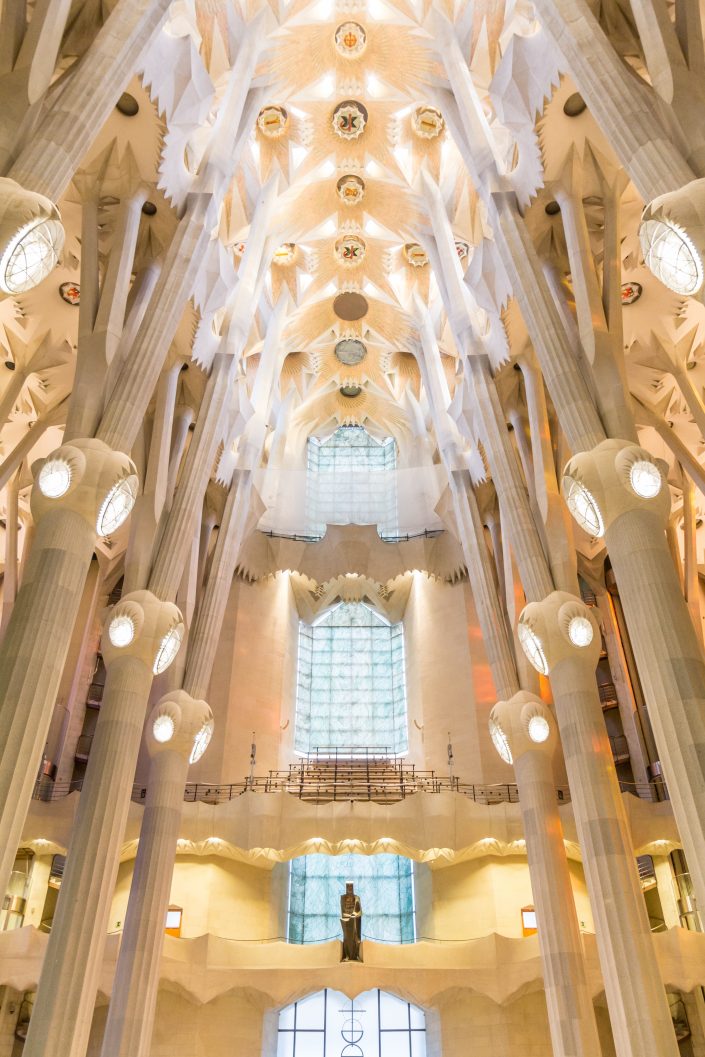
As for the architecture and the space it creates: it is incredible. The scale and ingenuity of the project is inspiring, and the interior is breathtaking. It is almost unbelievable that something so firmly modern could have been designed so long ago. There is no doubt in my mind that Gaudí was a genius.
There is a lot of debate about whether the basilica should ever have been finished. It is said that Gaudí always refined his ideas as he built, and that the plans would have changed considerably after his death as he continued to refine them during building. So, the argument goes, this is not truly Guadí’s work any more, even though the plans and design were his. I mention this because it strikes me as an interestingly prospective Ship of Thesus question. But whether or not it is Gaudí’s work, it is clearly the fulfillment of a cohesive vision, underpinned by architectural foresight, understanding and masterwork that may well have been unrivaled. The basilica cannot fail to impress.
So, what did I think of Barcelona’s Sagrada Família? My utterly contradictory conclusion is that the basilica is a masterpiece, an incredible and breathtaking work of profoundly kitsch bad taste that is both truly beautiful and as ugly as sin.
None of the photos in this post are my own: mine were crap. They are all pictures taken by people with much better photography skills than me, and used here under Creative Commons licences. The first (the wide shot of the Sagrada Família) is an edited version of a photo by Angela Compagnone. The second (the city skyline) is a cropped version of a photo by Joe Lin. The third (the spires) is by Danil Sorokin. The fourth (the Nativity facade) is a photo by Greg Nunes. The fifth (a brilliantly framed detail of the Passion Facade) is by Jessica To’oto’o. The sixth (showing part of the interior) is by Eleonora Albasi. The seventh (another interior shot) is by Paulo Nicolello. The eighth (the shot of Madrid Barajas) is by Ángel Riesgo Martínez. The ninth (the ceiling detail) is by Claudio Testa. The final photo (the interior of the Glory Facade) is by Won Young Park.
This post was filed under: Posts delayed by 12 months, Travel, Antonio Gaudí, Barcelona, Christianity, Churches, Religion, Sagrada Família, Spain, Travel.
Californian taxis, gun ownership and democracy
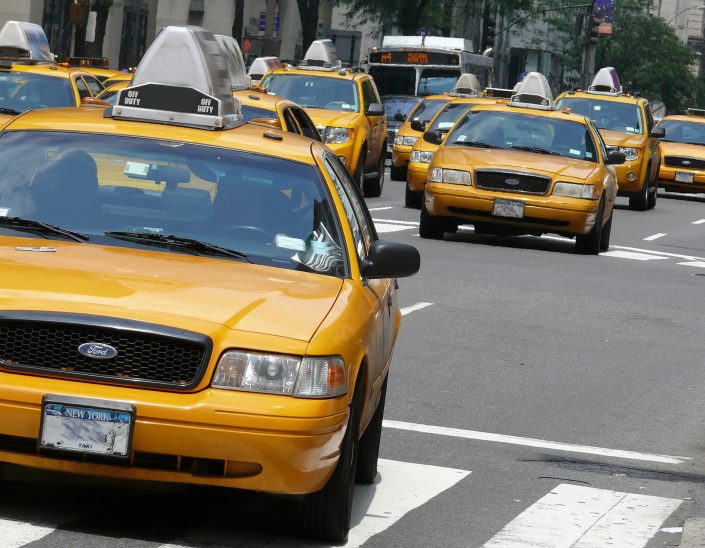
A couple of days ago, Wendy and I took a taxi from our hotel in San Diego to the airport, very kindly paid for by our hotel. The taxi driver was a chatty fellow and struck up the traditional “going to the airport” conversation beloved of taxi driver across the world.
Wendy mentioned that she was from Northern Ireland, which led to all the usual questions: Is that part of the UK? Is all of Ireland in the UK? Don’t the Northern Irish fight with the UK? Is Northern Ireland part of Brexit?
But then: What do people in the UK make of Trump?
Now, I thought we were on safe territory here. We were in California. Even I, as an uninformed Brit, knew California to be a true blue Democratic state. No Republican presidential candidate has won California this century.
Nevertheless, I played it safe with a politely non-committal response, suggesting that while Trump wasn’t personally very popular in the UK, Brits respected the outcome of the election, and the country is so interested in his impact that he’s rarely out of the British newspapers.
The taxi driver’s equal non-committal, “he’s surely shaking things up,” didn’t give any immediate indication of the transgression I’d made.
It was harder to remain neutral on his follow-up: “So what have you thought about guns while you’ve been here?”
Wendy’s eyes widened slightly as I admitted that I’d been slightly uncomfortable to see so many people with guns, from policemen on the streets to the border control officer who’d stamped our passport. This, I explained, was very different to the situation in the UK.
“But police are armed in the UK, right?”
I explained that a small number of officers carry weapons, and that there are armed rapid response units, but that the average police officer on the street carries nothing more threatening than a truncheon.
I’m afraid, dear reader, that this provoked a rant from our driver.
Firstly: “So that’s why you have so many terrorist attacks!”
Secondly, he asked whether I have heard of the campaigns in the UK for wider gun ownership. When I admitted ignorance, he blamed “the liberals that control your media”.
Thirdly, returning to California, he described his incredulity at the fact that he, both in his capacity as a private citizen and as a professional taxi driver, was not permitted to carry a concealed weapon. He told us how he was once, some years ago, robbed when getting out of his taxi. This would not, he suggested, have happened had he been carrying a concealed weapon.
Fourthly, he told us how Trump wants to allow anyone to carry a concealed weapon, and that this made him a great President. Our driver wasn’t sure that unrestricted concealed carrying of weapons would be allowed any time soon in California, because that state had “crazy laws” and a “corrupt Democratic governor”. He claimed that the Governor “hates guns and doesn’t want anyone to have them”.
Fifthly, he asks if we in the UK had ever heard of Crooked Hillary? “They call her that for a reason,” and one of the reasons is that she wanted to take away all the guns. Which would only lead to endless terrorist shootings like in the UK. He didn’t say that she should be locked up, but he might as well have done.
When I could get a word in edgeways, I pointed out that we had had no recent terrorist shootings in the UK. The driver said I was lying, that there was that arena attack in Manchester when all the kids were shot. I had no chance to point out that guns weren’t involved.
Sixthly, our driver told us that the many school shootings “around the world” were only being effectively tackled in the US, where upstanding citizens with guns shoot dead the shooters.
At this point, we pulled up outside Terminal 2 of Lindbergh Field and Wendy and I barrelled out of the taxi while thanking the driver excessively in a very British manner.
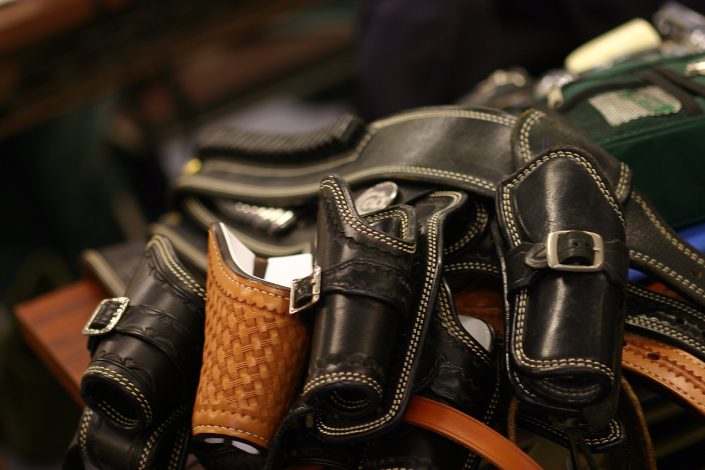
As he drove away, Wendy and I looked at one another and breathed. I think we were both in a sort of mild shock. The conversation made us reflect on how one can’t really have a sensible political conversation with someone whose factual frame of reference is so divorced from reality.
It made me reflect on the threat of “fake news” – a problem long before social media came along, but perhaps amplified by it. Continual exposure to counterfactual stories shifts one’s frame of reference, and make seemingly illogical conclusions entirely rational.
It made me reflect on how much more difficult political life must be these days: how can a politician ever thrive if their views are misrepresented even by their supporters and to their supporters? A politician cannot deliver on a promise they have never made, and cannot defend themselves against false accusations when every correction is percieved as a “cover-up”.
This conversation was something of an epiphany for me, helping me to see how broken this part of our society has become. In decades past, we lived in a world where the means of publication were (to all intents and purposes) controlled, and we could (by and large) distinguish fact from fiction. Today, anyone can publish anything, and few people have the will or means to verify any of it. We’ve moved from a world of limited reliable information to a world where every scrap of information is at our fingertips, but we can’t tell which morsels are fact and which are fiction. And yet, in a democracy, we rely on the population making that distinction accurately in order to make the right decisions for society.
I have no solutions to offer for any of this. In his book, Ryan Holiday suggests that subscription-based news is the answer, as it places value on truth over page views. The BBC likes to present itself as part of the answer. Tech companies sometimes suggest that the algorithmic triangulation of stories can play a role. People with minds more radical than mine might suggest that this is the time to find some other form of democracy than directly voting for a legislative representative.
I’ve no idea who is right. But in the course of one taxi journey, I’ve been convinced more than ever that an answer is urgently needed.
The taxi image at the top of this post is by Ad Meskens. It gives the slightly misleading impression that Wendy and I were travelling in a yellow cab, when in fact we were in more of van. The gun hoslter image in the middle of the post is by Takeshi Mano. Both images are used here under their Creative Commons licences.
This post was filed under: News and Comment, Politics, Posts delayed by 12 months, Travel, California, Guns, Reflection, Travel, USA.
The assassination of JFK
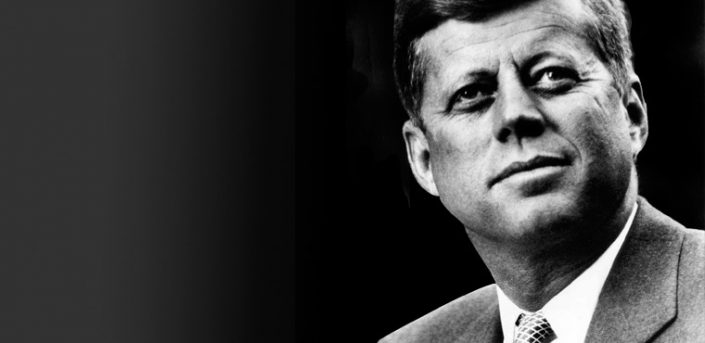
The assassination of President John Fitzgerald Kennedy occurred 22 years before I was born. Nevertheless, his presidency and untimely death are such important moments US history that I think most people feel a connection to them, even those of us who didn’t live through them. Myriad cultural references and endless conspiracy theories have kept the assassination in the collective conscious, while the presidency is still very frequently discussed in the context of the Bay of Pigs disaster, the announcement of the goal to land men on the moon, and members of the wider dynasty demonstrating political ambition.
The events at Dealey Plaza in Dallas on Friday 22 November 1963 have been examined and re-examined countless times. Over the years, despite making no special effort, I’ve must have read a huge number of articles about them and have seen countless documentaries, from sober retellings to explorations of outlandish conspiracy theories. I imagine most people are in the same boat.
And so earlier this week, I was intrigued to have the opportunity to visit Dealey Plaza for myself. It wasn’t quite as I had expected.
The former Texas School Book Depository is still there and looks much as it does in the assassination footage. The Sixth Floor has been turned into a museum to the assassination, which I didn’t have chance to visit.
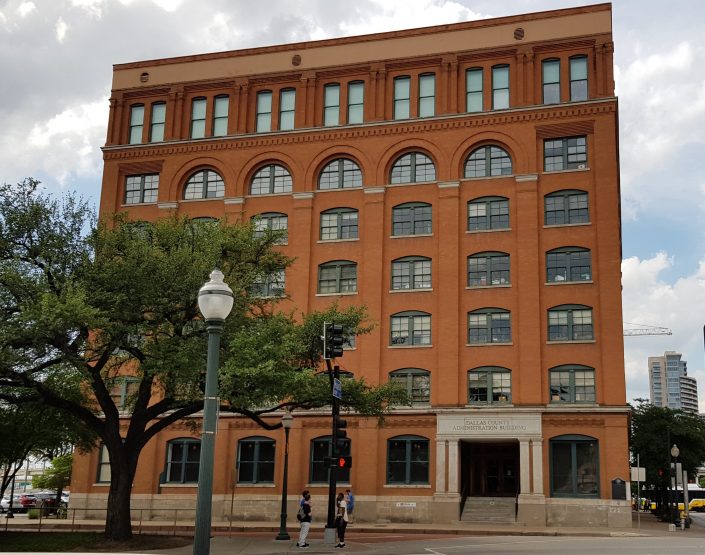
As you can see in the bottom-right of the above photo, the building is marked by a large plaque. This sets out the long history of the site, dealing with the assassination only in the final paragraph, with seemingly permanent scratching acknowledging the conspiracy theories surrounding the “official” version of events.

On the road below, a crudely drawn “X” marks the spot the motorcade was passing as the fatal shot was taken, with part of the much-discussed grassy knoll immediately behind it. The road remains a rather busy traffic thoroughfare, albeit one with random strangers standing and gawping from the pavement (including me).
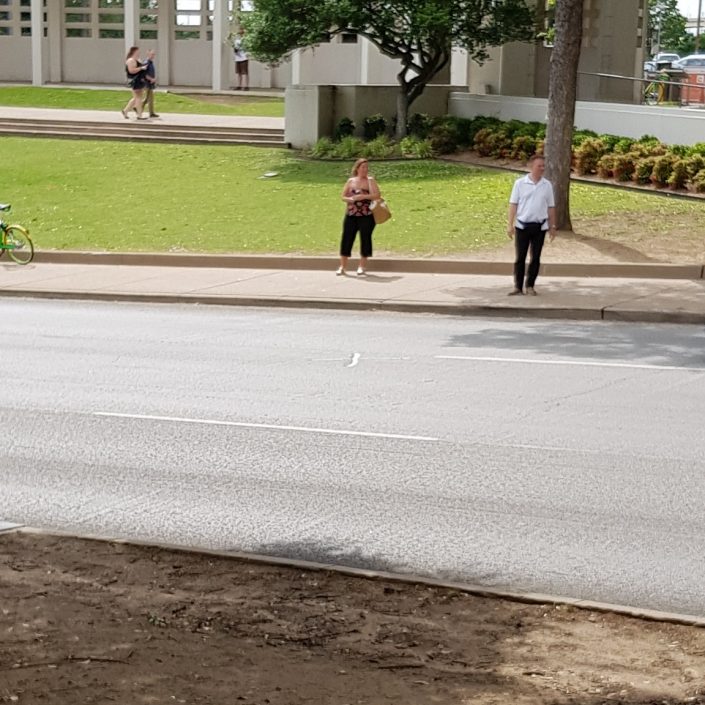
My over-riding impression was that the whole site was far smaller than I had imagined it to be. Dealey Plaza itself wasn’t very big, and the key locations are within a roughly 50m square. I always had in mind that the shots fired had to travel quite a long way to meet their mark, much like the Hollywood trope of the long-range sniper. In fact, everything was really rather close together. Despite thinking that I had a good idea of what had happened, my mental image was completely wrong.
Until I visited, I had no idea there was a memorial plaza to Kennedy a short distance away. The actual memorial takes the form of a sort of concrete screen, intended to be suggestive of a sort of open tomb.
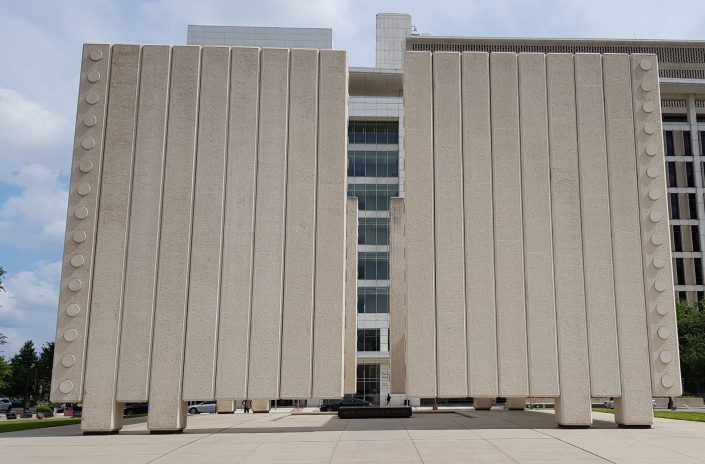
In the centre is an empty plinth.
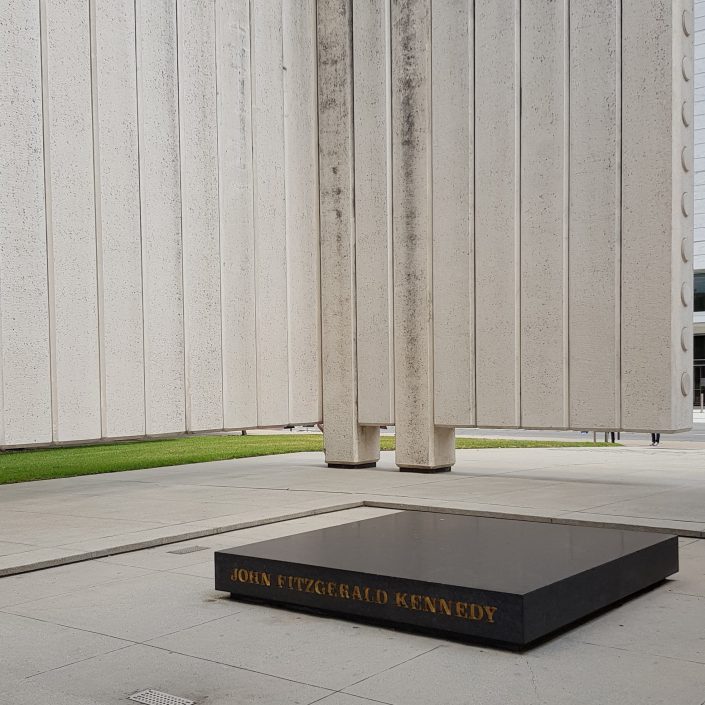
This caught me a bit off guard. Despite (or perhaps because of) the simplicity of the design, standing alone in an almost silent enclave in the centre of a very busy city with nothing to look at but the absence of a revered man is really quite a moving experience. The memorial was funded through contributions from thousands of individual citizens of Dallas, in a manner that seems both poignant and somehow dated: erecting a monument by public subscription feels like something that happened in the Victorian era more than the 1970s. Perhaps it’s due for a come-back.
I’m glad I visited, and feel like the visit has given me a new perspective on an important event of the 20th century. But at the same time, I have to confess that it all feels a little bit wrong to me. This is the scene of one of the most notorious murders of our time, and it feels a little bit like it has been turned into a tourist attraction. There is a even a café and gift shop. I’m one of the tourists, and appreciate the hypocrisy of this stance, but I can’t help but feel that this isn’t how anyone would want to be remembered. Would anybody really want such a focus on their death as opposed to their life? Why would anyone want to be remembered as the victim of their own murder, as opposed to being remembered for their lifetime of achievements?
Perhaps it doesn’t matter what the subject would have wanted. Perhaps it is important to use the attraction of the historical site to make sure that people are educated about the historical event—and if someone makes a profit as a result, then that’s just the American way. But I have to confess that my feelings of interest and intrigued as I wandered round were mixed with a slight feeling of ickiness. Still, I’m glad I visited.
The picture of JFK at the top of this post is in the public domain. The others are all my own.
This post was filed under: Posts delayed by 12 months, Travel, Dallas, JFK, Texas, Travel, USA.
Crossing the US-Mexico border
Yesterday, while Wendy was busy presenting at an international conference, I crossed the border from California to Tijuana to go exploring.
From San Diego, this was very straightforward. The Blue Line on the San Diego Trolley took me directly to San Ysidro, the district on the US side of the US-Mexico border. The Trolley stop is maybe 200 metres from the border crossing point, and there are helpful signs to put the way. There are also lots of slightly threatening signs from the US Government about covert monitoring.
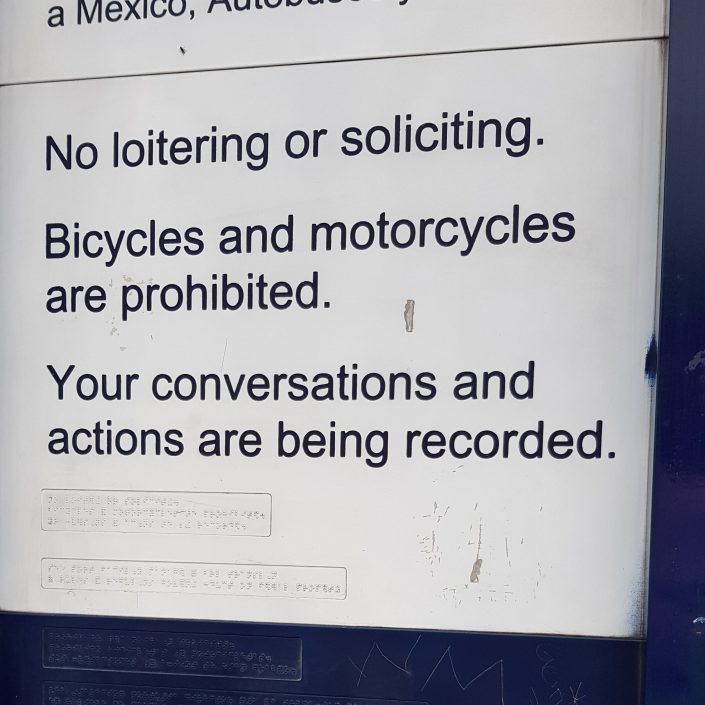
There are, in fact, two pedestrian border crossings: one near the Trolley station, and one a short walk away by the Border Outlet Shopping Centre. I took the former (better sign-posted) option, walking up what felt a lot like a back alley behind a coach station to the border crossing point.
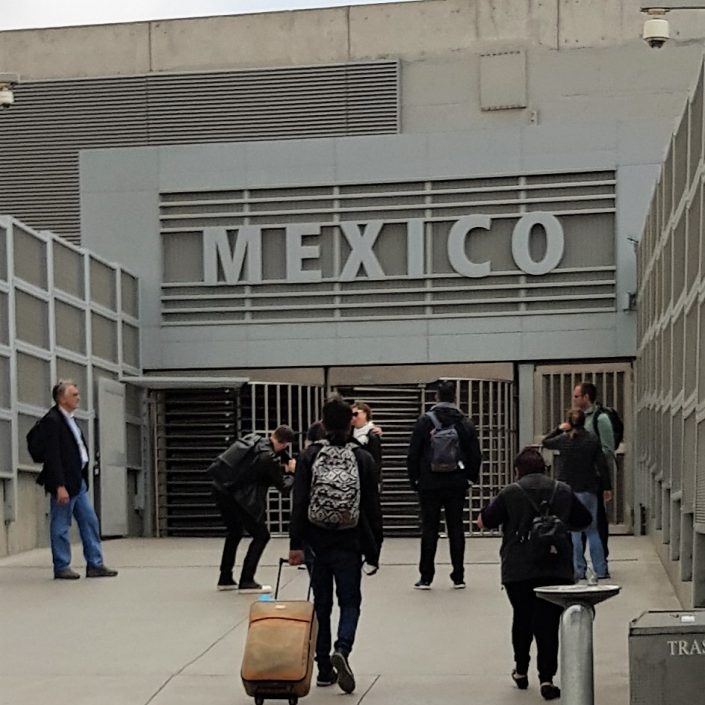
On entering through the slightly threatening no-return gates, I entered a border crossing, reminiscent of a typical airport border point. There was a very long queue for people with Mexican passports, but nobody in the queue for people who, like me, had foreign passports. This phased me a bit: I knew from my prior research that I needed to fill in an immigration card, but could see neither a card nor anywhere to fill it in. In the end, I just approached one of the border agents’ desks, where a friendly officer told me not to worry, it was quiet, and I may as well fill it out at her desk, which I did while she checked my passport.
We made small talk about this being my first time in Mexico (she was amazed), her previous experiences of visiting London and the sights of San Diego I’d seen so far. Before long, she’d stamped my paperwork and sent me on my way. After this point, customs x-ray searched any large luggage, but as I had none I was straight back outside and in a new country.
From here, it’s typically a 20-minute walk to the touristy area around Avenida Revolución, but I went a bit wrong, crossing over a highway on the footpath of a road bridge rather than the more direct pedestrian bridge, so it took me about half an hour. This walk is not through a particularly attractive area. I was pestered frequently by disabled and often elderly beggars, street sellers, and taxis pulling up alongside me to offer me lifts. Looking down on the vehicular border crossing, I could see stall upon stall with sellers plying their trade to people waiting in the long, seemingly stationary queue for the US border.
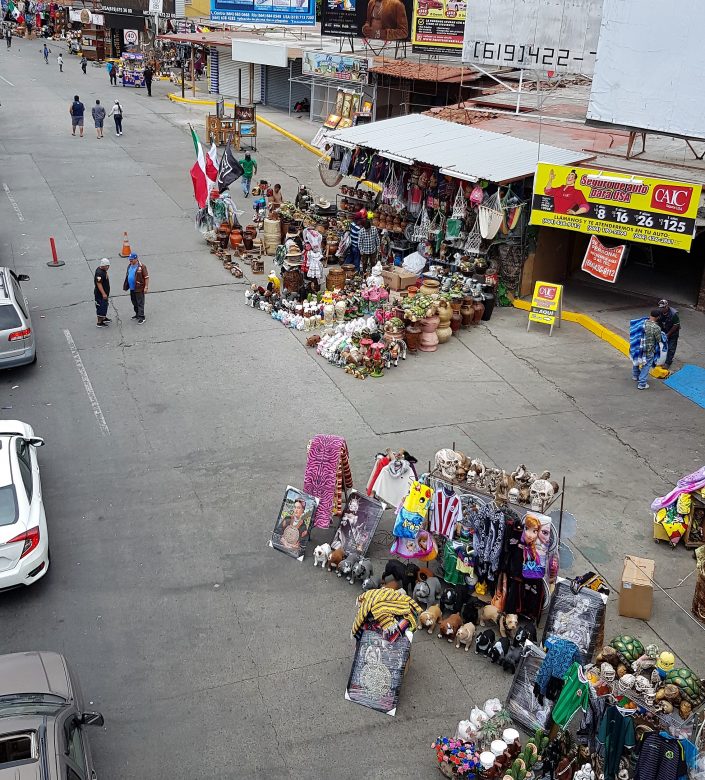
I walked through expanses of largely deserted civic architecture with broken fountains and such surrounded by closed up shop units. It was a bit eerie. I’m not sure whether this is attributable to me visiting on a Sunday or to the significant downturn in the Mexican economy in the decades since Tijuana was a real draw for tourists.
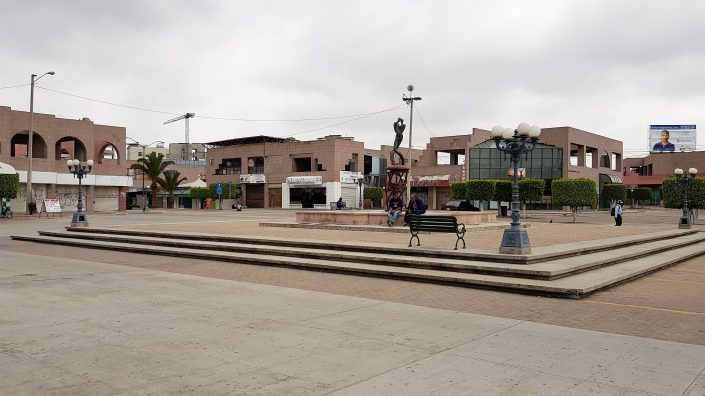
Here and there along the way, there were small stores and restaurants whose seemingly desperate owners practically begged me to come in and look at their wares, often offering free alcohol as an enticement. I’m afraid I declined.
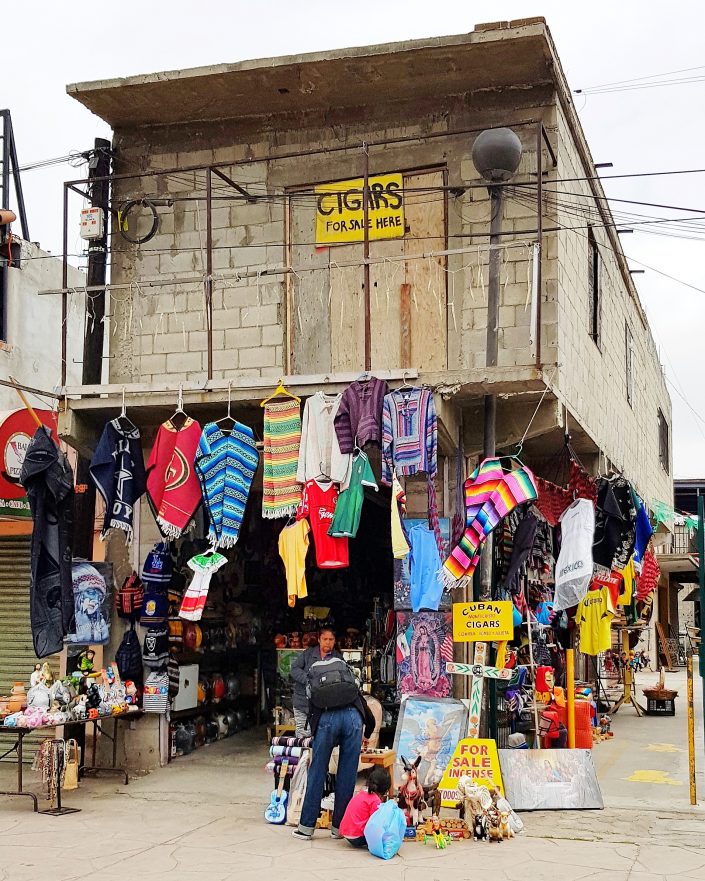
My own idiocy in taking the wrong bridge notwithstanding, it was actually quite easy to navigate to Avenida Revolución thanks to the visible-from-everywhere Tijuana arch, which stands right in the centre. Rather disappointingly, the sign in the middle seems to have changed from the famous ‘Bienvenidos a Tijuana’ on a Mexican flag background to something “modern” sponsored by Samsung.
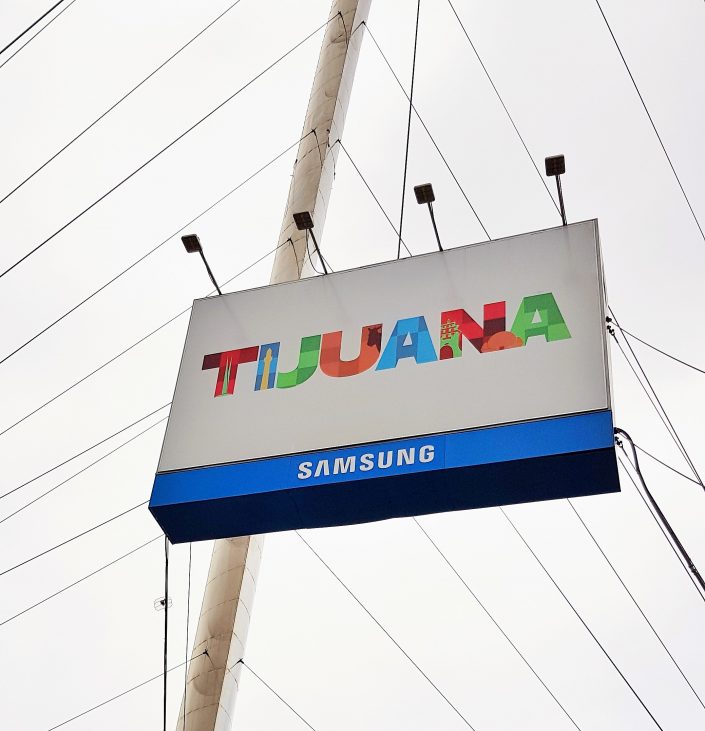
The area around Avenida Revolución was lively in every sense, with performers drawing large crowds, street vendors enthusiastically shouting about their products, and bars and restaurants making keen efforts to attract the passing traffic. The famed decorations around Santiago Argüello lent a party atmosphere to the whole area.
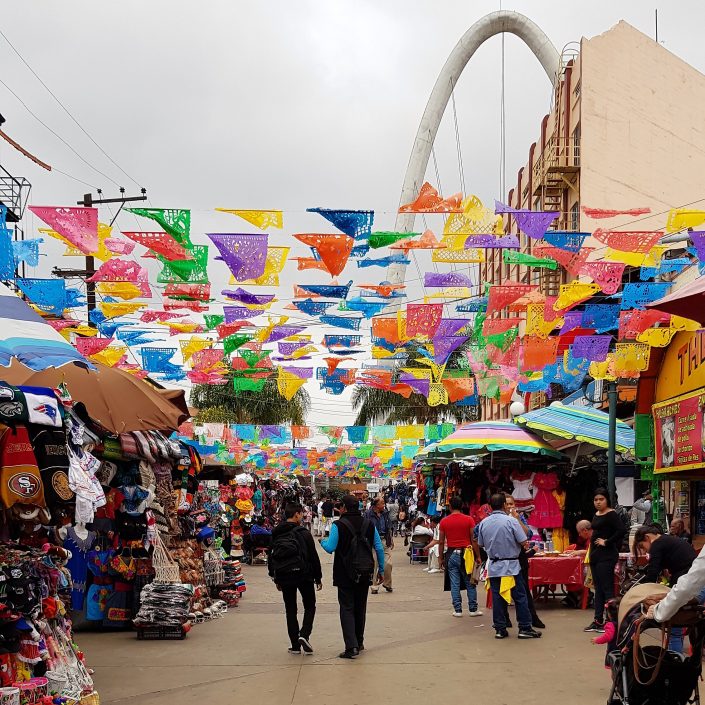
And yet, I found it hard to forget the scenes of deprivation and desperation I’d walked through to get to this point, not least as I knew I was going to have to walk back the same way before too long. This left me feeling a little melancholic. Nevertheless, I had a good wander around, aimlessly soaking in the atmosphere rather than rushing into any of the frequently advertised tourist attractions.
I got far less lost on the way back thanks to very frequent signage to the US border. I crossed back over at the other of the two border crossings I mentioned.
There could hardly have been a more marked difference between the manner of the crossing in the two directions. As soon as one stepped through the gates to the US border crossing complex, frequent stern signs forbade the use of mobile phones and cameras. Crossing back into the USA involved a walk through a labyrinthine concrete corridor ending with an almost whimsical spiral concrete ramp to even reach the border crossing point. I had to queue for a little over an hour to meet the US border agent, who questioned my intentions in crossing the border in some detail. He also seemed a little confused by the fact that my passport was for both the United Kingdom and Northern Ireland, which hardly inspired confidence, but he did eventually let me through.
The fact that the US-Mexico border is the first controlled land border I’ve ever crossed probably says more about the remarkably peaceful times in which I’ve lived that it does about me personally. At the time I crossed the Denmark-Sweden border it was technically manned, but this just involved someone passing through my train cursorily glancing at passports. Some pundits currently predict something similar will be in existence between Northern Ireland and the Republic by the time this is published: I think that’s nonsense, but that’s perhaps a post for another time.
At the moment, I’m part-way through Rutger Bregman’s Utopia for Realists. In this book, which argues for a borderless world, the US-Mexico border is cited specifically as one which inflicts economic harm on people on both sides. I found the apparent difference in living standards quite shocking: it seems mildly crazy that people living in two developed countries and so physically close to one another can have such different life experiences and prospects.
There has been much written over the last few months about the level of poverty in California, despite its reputation as a liberal state. Wendy and I have both been quite surprised to see the seemingly high number of homeless people in San Diego. Crossing the border, I felt as though there was a far greater degree of profound poverty in Tijuana, but perhaps California’s poverty is just better hidden than Tijuana’s. Appearances can, after all, be deceiving.
I’m glad I took the time to visit Tijuana while I’m over here in California. The experience wasn’t at all what I had expected: rather than a tacky pastiche Mexico “mini theme park” which I had thought would exist on the other side, the reality has left me more pensive and reflective than I would have expected. And that’s no bad thing.
Fairly obviously, all of the photos in this post are my own.
This post was filed under: News and Comment, Posts delayed by 12 months, Travel, California, Mexico, Reflection, Tijuana, Travel, USA.
Flying and thinking
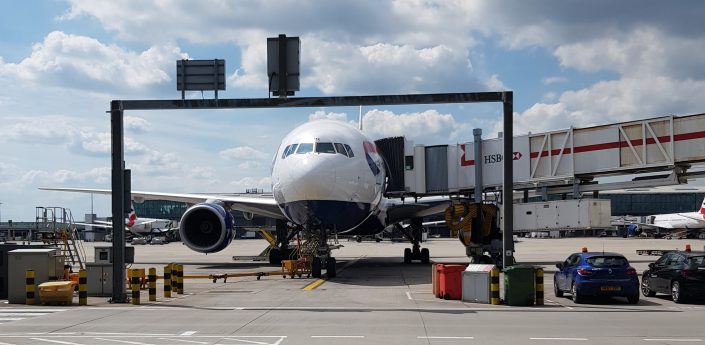
As I type, I’m 34,000 feet above Greenland on my way to San Diego aboard a British Airways Boeing 777-200. Wendy is snoozing next to me, fully reclined with eye mask in situ.
Apart from the miracle of travelling at 550mph across the globe in a pressurised metal tube, things aren’t going so well. The in-flight entertainment system broke after the first hour of the flight—perhaps I’ll never know what happens in the second half of The Greatest Showman—and for the last three hours we’ve had too much turbulence for me to be able to comfortably read. The combination of free alcohol, no entertainment and people strapped to seats is leading to a somewhat tense atmosphere with complaints being fired at the harried crew from all angles. Worse, they’ve now completely run out of gin on board.
We’re on a last-minute replacement plane whose interior has seen better days, and the resulting re-allocation of seats means that Wendy and I are sat immediately next to the toilet. I realise someone has to sit here, but I paid to select our seats so that it wouldn’t be me. Like most people, my sense of egalitarianism seems to have evaporated as soon as I felt that I’d got the raw end of the deal.
And yet, there’s rather lovely about being in splendid isolation from the rest of the world. Fortunately, this plane doesn’t have wifi. So with nothing to watch, an inability to read, and a sleeping wife, I’m just sitting here and thinking. How often does anyone get the chance to do that?
I have a natural inclination towards spending time with my own thoughts. As I walk to work in the morning, I typically listen to music or a podcast, but my journey home is usually spent just thinking things over. I think it helps to keep me sane. Rarely, though, do I get the chance for a more prolonged period of thought.
I realise the irony that I’m now writing this thought down, laptop balanced on knee, with lots of turbulence-induced typos being corrected as best I can. If you’re wondering: I’m saving this in the Evernote app on my Chromebook to post later.
And that’s really all there is to say. I’m going to put my laptop away again now and return to quiet contemplation. Over and out.
The photo at the top was taken by me earlier today.
This post was filed under: Posts delayed by 12 months, Travel, British Airways, California, Flying, San Diego, Travel, USA.
Cruise ships and me
Last week, I read this remarkable story about a new cruise ship by Oli Franklin-Wallis in Wired, and have been thinking about it ever since:
Symphony of the Seas – which, on its maiden voyage from Barcelona in March 2018 became the largest passenger ship ever built – is about five times the size of the Titanic. At 362 metres long, you could balance it on its stern and its bow would tower over all but two of Europe’s tallest skyscrapers. Owned and operated by Miami-based cruise line Royal Caribbean, it can carry nearly 9,000 people and contains more than 40 restaurants and bars; 23 pools, jacuzzis and water slides; two West End-sized theatres; an ice rink; a surf simulator; two climbing walls; a zip line; a fairground carousel; a mini-golf course; a ten-storey fun slide; laser tag; a spa; a gym; a casino; plus dozens more shopping and entertainment opportunities.
Cruise ships mean two things to me.
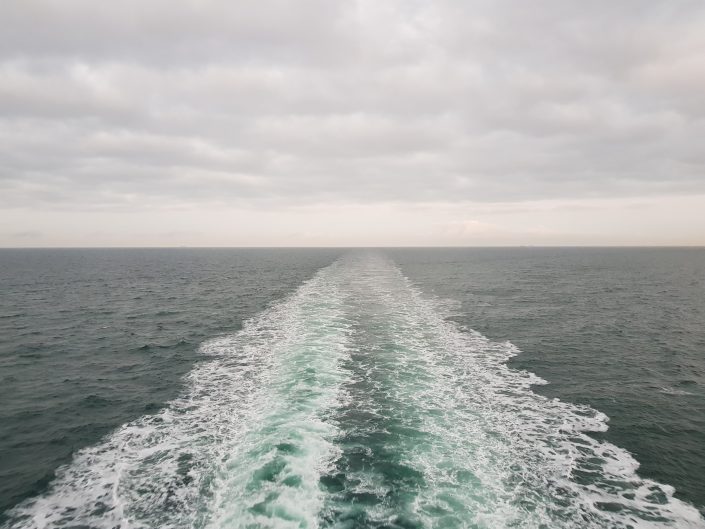
Earlier this year, I went on a ‘mini-cruise’ from Newcastle to Amsterdam aboard a DFDS ship. The journey was an overnight 15 hour or so thing, so certainly not equivalent in any way to spending weeks at sea on the world’s biggest cruise ship. The rationale for this was that I fancied a last-minute break and couldn’t find a cheap flight from Newcastle, so went on a cheap boat instead, spent a day in Amsterdam, and took a cheap flight from there. This worked remarkably well, and I’d do it again.
This was the first time I’d been on an overnight boat since our annual family camping trips to France when I was a child. Prior to going, I’d sort of thought in the back of my mind that I might be the sort of person who might one day enjoy a proper cruise. This experience put me off.
The ship was lovely, and I was particularly impressed by the cabin. I had expected a pokey bunk-bedded hovel but was actually rewarded with a fairly large space which looked not unlike a Travelodge room, with an en-suite bathroom. The food on board was also much higher quality than I would have expected. But I am somebody who likes to wander—and even with only 15 hours on the ship, I was itching to get off and explore. Exploring the ship felt a bit constrained.
It was silly of me not to realise this in the first place. Wendy and I ruled out going to an idyllic holiday resort last summer for the sole reason that it was located on a main road along which walking was not advised, so we couldn’t ‘go for a wander’ without catching a bus or taxi somewhere first. I hadn’t really clocked that ‘going for a wander’ wasn’t really a go-er on a ship.
While the Symphony of the Seas is ridiculously bigger than the ship I was on (it’s more than twice as long and can take four times as many passengers across twice as many decks), I still think I’d feel ‘cooped up’ pretty quickly. So I don’t think I’ll be going cruising anytime soon.
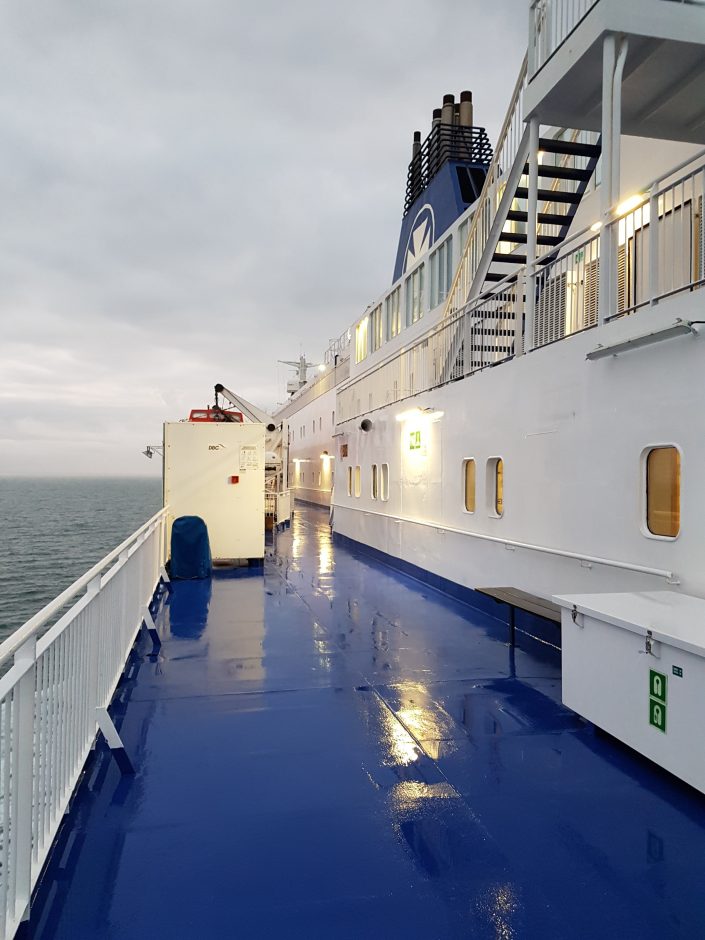
My other relationship with ships is professional. One of the more esoteric parts of my role as a Consultant in Health Protection is that I am the designated Medical Officer for a number of ports. This gives me certain legal responsibilities relating to ships and the health of their crew—most of which are thankfully delegated to people much more expert than me. But just imagine how complex an outbreak of norovirus or Legionnaire’s disease could get on a ship as huge as Symphony of the Seas. I was fascinated to read in Oli’s article about some of the steps taken to mitigate the risks:
“The level of hygiene is extreme,” Yrjovuori announced, as we passed a hand-washing station. Though ship-wide outbreaks of sickness make the news at least once a year, the total number of passengers who fall ill is a fraction of one per cent. But close quarters enable outbreaks, so sanitation regulations at sea are stringent. Every part of the ship, from lift buttons to the casino’s chips, are sanitised daily; interior materials have to stand up to the high level of chlorination from the constant cleaning. Rubbish is frozen in vast storage containers to slow bacteria growth and is only removed in port.
Fascinating stuff… perhaps we could even try and replicate some of it on land!
The pictures in this post are my own from the above-described ‘mini-cruise’ adventure. The pictures in the Wired article are a great advert for the power of print, looking far more arresting as double-page spreads than as on-screen images.
This post was filed under: Health, Posts delayed by 12 months, Travel, Amsterdam, Cruises, DFDS, Newcastle-upon-Tyne, Port Health, Public Health, Ships, Travel.
Thoughts on the restoration of ex-BBC Television Centre
I’m writing this in the courtyard of Television Centre in West London, which I happened to be passing today. I’m gazing up at the newly restored statue of Helios and watching the repaired fountains dance as they never have on any previous visit.
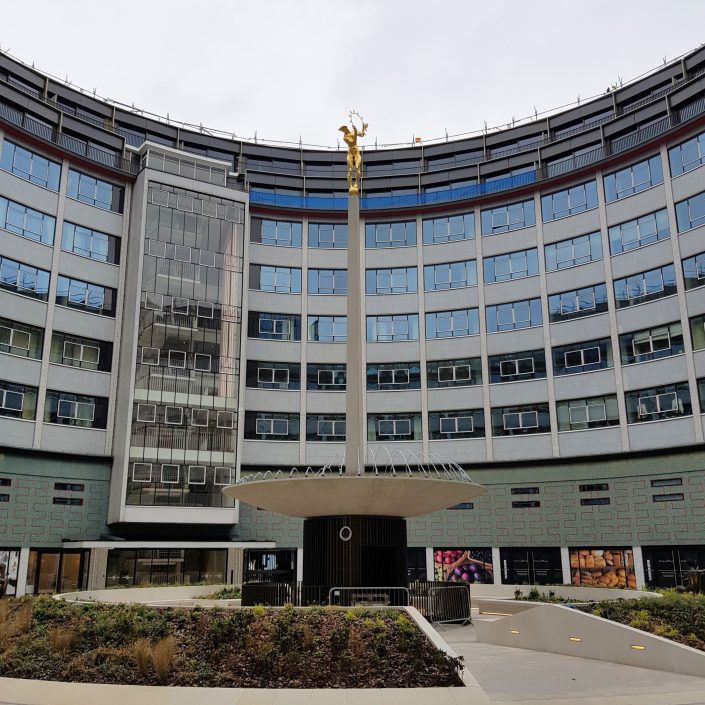
I think for most British people of my age, Television Centre is the home of Going Live, Live & Kicking, Blue Peter, Ed the Duck, Otis the Aardvark, and Philip Schofield and Andi Peters’s broom cupboard. After the BBC moved off the site in 2013, it has been closed for restoration and redevelopment, with luxury apartments the order of the day—albeit with three television studios remaining. It seems ironic that two-thirds of the studios in a location so closely associated with the BBC are to become the new standing home of iconic ITV programmes like This Morning any day now.
I last visited Television Centre with Wendy, a few months before it closed.
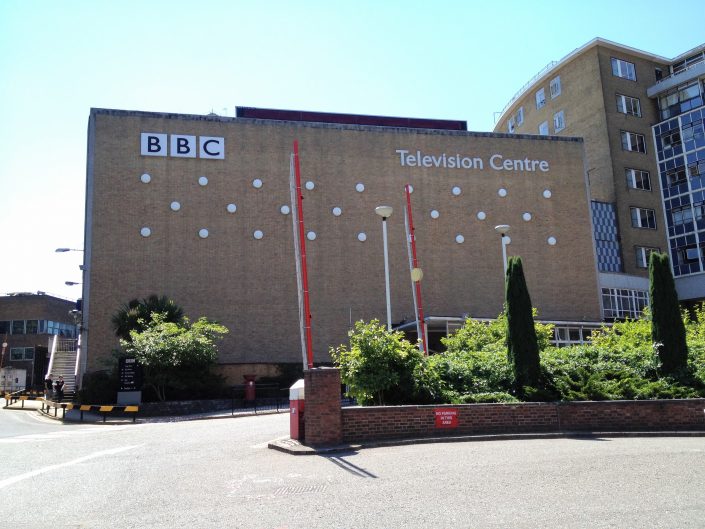
We were lucky enough to secure a place on one of the final tours of the building and were fascinated to get an understanding of the mechanics of production of TV shows (and especially news programmes). This aspect was far more interesting to both of us than the celebrity anecdotes, tour of the Match of the Day set, or inevitable visit to the gift shop.
We both felt a little uncomfortable at the tour of the ‘celebrity’ dressing rooms, knowing that they were the settings for sexual abuse: our visit coincided with a 12-month period in which horrific historical examples of abuse at the BBC were being recalled almost daily on the front pages of newspapers. The fabric of the building was also falling apart at the seams, the sense of magic ebbing away with the physical as much as the moral dilapidation.
Towards the end of the tour, we were press-ganged into making up the numbers for the studio audience of a recording of a truly terrible daytime game show which we’ve seen neither hide nor hair of since. In a high-pressured time-limited trivia finale, the host fluffed the reading of almost every question. He then got to record ‘pick-ups’, having a second (and occasionally third) go at reading them correctly. The contestant didn’t get a second go at answering them, and so presumably ended up appearing inexplicably flummoxed by perfectly simple questions, through no fault of her own. “TV magic”, it seems, still favours the “talent”.
This afternoon, Television Centre is quiet. In fact, as I tap away, I’m the only person in the courtyard. At least from the outside, the restoration appears sympathetic. The front of the site looks all the better for the landscaping that has replaced the exterior car park, which also has the effect of making the Centre seem smaller and more intimate.
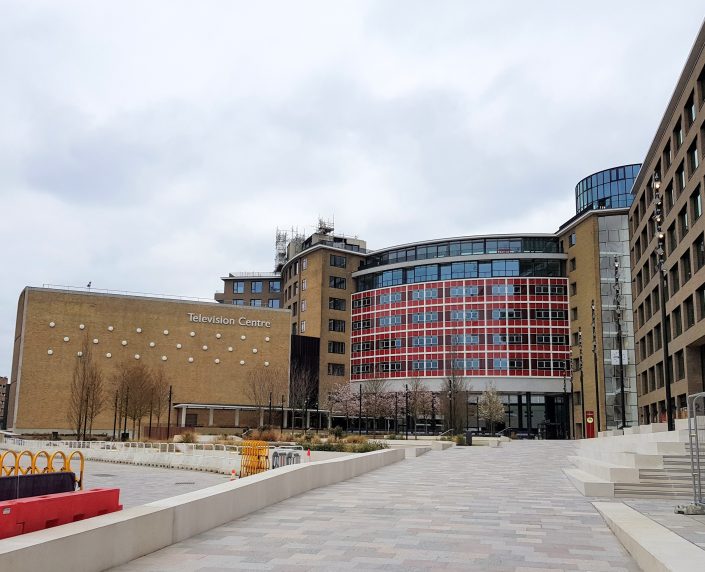
I expected to feel a certain sense of melancholy from coming to a place to which I once felt such a close connection, knowing that a part of our collective cultural heritage had been auctioned off to the highest bidder and converted into apartments I could never hope to afford. And yet, that is not how I feel.
Perhaps incongruously, I feel a strange sense of satisfaction at seeing the building sympathetically restored. The impression is of quality and accessible historical grandeur, and it feels strangely as though the hope for the future inherent in redevelopment has frightened away the collected ghosts of the past.
It doesn’t feel like a wonderous “TV factory” any more, as it did from a distance in my childhood; but nor does it feel like a tainted crime scene, as it did on my last visit. It feels like a housing development sympathetically built around a listed building—which is, I suppose, exactly what it is.
This post was filed under: Posts delayed by 12 months, Travel, Architecture, London, Media, The BBC, Travel.
